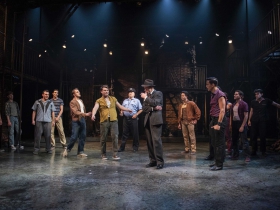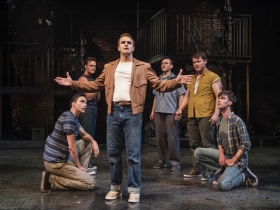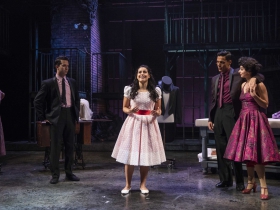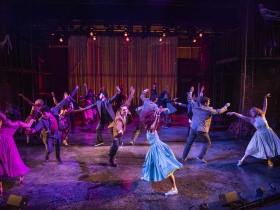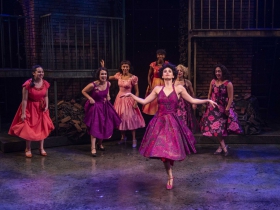A Tony To Die For
He leads Milwaukee Rep’s most incisive musical to date, ‘West Side Story’
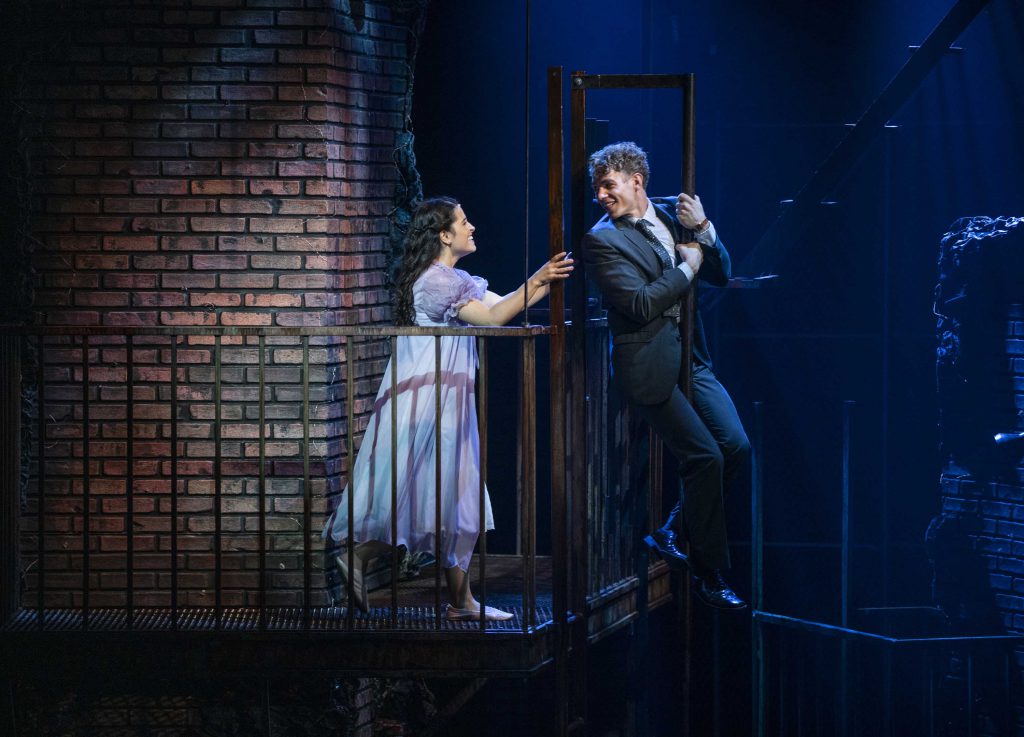
Milwaukee Repertory Theater presents West Side Story in the Quadracci Powerhouse September 17 – October 27, 2019. Left to right: Liesl Collazo and Jeffrey Kringer. Photo by Michael Brosilow.
Most people know “West Side Story” from a 1961 movie version brought back to the big screen this year by TV’s Turner Movie Classics. Its singing leads were dubbed. It needed the adept ministrations of two directors, Robert Wise and original choreographer Jerome Robbins, to stir life within the star system. But next year, film director Steven Spielberg is promising a “West Side Story” timely to a new America and in December Broadway begins “modernized previews” advertising real Latinos as the Sharks.
Milwaukee doesn’t have to wait. The Latino Sharks are the real deal in the Milwaukee Rep version running through October 27. The dancers are outlandishly agile on the floor and on their feet. In fact, for large chunks and overall vision, this is the best musical artistic director Mark Clements has helmed on the mainstage.
Clements has re-established that this musical belongs most mightily on the live stage, with a poetic and symbolic intention that far outweighs its street gang milieu – you know, the Jets and Sharks fighting for a piece of New York turf. The would-be snappy dialog outside the songs shows some age, but the passions underlying the music and the characters resonate.
Clements restores to the original what the 1961 movie had the most difficulty with – the sudden and fevered romance of the Tony and Maria characters (the Pole and the Puerto Rican), with the Tony here, Jeffrey Kringer, the best Milwaukee has experienced in both singing and emoting. His Maria, Liesl Collazo, almost keep pace until the extra sugar in the part catches up. But both sing powerfully in solos and duets, with Kringer in particular providing the relaxed certainty of full-throated ardor without which the musical fails despite the familiarity and fascination of a Leonard Bernstein score of unconventional harmonics and feisty jazz. Were Kringer not such an astounding debut for the Rep, I suspect Collazo’s Maria would get greater appreciation.
Occasionally Clements seeks more symbolism than the musical’s spine can stand. But either he or Kringer came up with a powerhouse reality in a death scene that makes us suffer. And the ballet sequence eliminated in the film is evocatively danced and sung, one of the surprising pleasures of this version.
The pointed overlay – it’s as if the Rep is quietly reminding us that gun violence and tragic indifference to Puerto Rico are hardly strangers to our shores 62 years later.
One stretch in the first act –“Something’s Coming” to “Dance at the Gym” to “Maria” to the balcony scene to “America” to “Cool” – set a formidable future standard for the Milwaukee Rep.
Aided by Yael Lubetzky’s remarkable lighting patterns, choreographer Jon Rua has not been afraid to play with the original Robbins choreography for a three-sided stage, while Todd Edward Ivins’ stage design has cleared the front and uses mobile props and upstage scaffolds, balconies and wire fences to rotate the action swiftly.
There may be some sound wizardry at work but that should not detract from huzzahs for the six piece orchestra led by Dan Kazemi. Technically the production feeds back into Clements’ vision. Rather than showing off, each element is subtly integrated.
One caveat is that the actor-dancers needed for the Jets and the Sharks seem a tad too polished – and punch too hard — for the gang aura of the 1950s. Most theatergoers will accept the convention (polished training that belies the image of spontaneity) but it does hurt in the casting of Jacob Burns as Riff.
Even if some of the men seem a tad beyond the rumble-like posturing, they and their assorted women can move and mimic. Among the standouts as dancer and singer are Courtney Arango as Anita and Hope Endrenyl as a startlingly good Anybodys. The adults in this musical are almost thankless clichés, so be thankful for Rep veterans like James Pickering and Jonathan Wainwright.
Have you noticed how musicals and songs from more than a half century ago are enjoying a national revival? It’s because of both new colors and old verities our culture finds in them. Milwaukee theaters may actually be ahead of the curve.
“West Side Story” Gallery
Dominique Paul Noth served for decades as film and drama critic, later senior editor for features at the Milwaukee Journal. You’ll find his blog here and here.
If you think stories like this are important, become a member of Urban Milwaukee and help support real independent journalism. Plus you get some cool added benefits, all detailed here.
Review
-
Ouzo Café Is Classic Greek Fare
 May 23rd, 2024 by Cari Taylor-Carlson
May 23rd, 2024 by Cari Taylor-Carlson
-
‘The Treasurer’ a Darkly Funny Family Play
 Apr 29th, 2024 by Dominique Paul Noth
Apr 29th, 2024 by Dominique Paul Noth
-
Anmol Is All About the Spices
 Apr 28th, 2024 by Cari Taylor-Carlson
Apr 28th, 2024 by Cari Taylor-Carlson
Theater
-
‘The Treasurer’ a Darkly Funny Family Play
 Apr 29th, 2024 by Dominique Paul Noth
Apr 29th, 2024 by Dominique Paul Noth
-
Rep’s Nina Simone Play a Puzzle
 Apr 23rd, 2024 by Dominique Paul Noth
Apr 23rd, 2024 by Dominique Paul Noth
-
Skylight’s ‘Eternity’ Is a Slam Bang Show
 Apr 15th, 2024 by Dominique Paul Noth
Apr 15th, 2024 by Dominique Paul Noth

